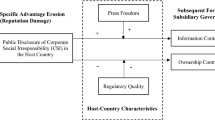Abstract
This paper proposes a two-stage game theoretic model where the discretionary power of executives acts as an implicit defense against hostile takeovers. Following managerial enterprise models, this paper analyzes the effects of discretionary power of target’s executives over R&D and advertising expenditures in defeating hostile takeover attempts. It is shown that in vertically differentiated industries, in equilibrium, target’s executives keep low level of R&D and advertising expenditures to make their firm an unattractive target for hostile takeovers. The model reveals that executives are influenced by their self-interest of monetary and non-monetary benefits and this self-interest makes the industry more differentiated.
Similar content being viewed by others
References
Berkovitch E, Narayanan MP (1993) Motives for takeovers: an empirical investigation. J Financ Quant Anal 28(3): 347–362
Bloch F, Manceau D (1999) Persuasive advertising in Hotelling’s model of product differentiation. Int J Ind Org 17(4): 557–574
D’Aveni RA, Kesner IF (1993) Top managerial prestige, power and tender offer response: a study of elite social networks and target firm cooperation during takeovers. Org Sci 4(2): 123–151
Deakin S, Hobbs R, Singer G (2001) Implicit contracts and corporate governance: the impact of the city code on takeovers and mergers. In: CMI Workshop paper. Cambridge University Press, Cambridge
Deroian F, Gannon F (2006) Quality-improving alliances in differentiated oligopoly. Int J Ind Org 24(3): 629–637
Easterbrook FH, Fischel DR (1981) The proper role of a target’s management in responding to a tender offer. Harv Law Rev 94(6): 1161–1204
Franks J, Mayer C (1996) Hostile takeovers and the correction of managerial failure. J Financ Econ 40(1): 163–181
Gabszewicz JJ, Thisse JF (1979) Price competition, quality and income disparities. J Econ Theory 20(3): 340–359
Gaughan PA (2007) Mergers, acquisitions, and corporate restructurings. Wiley, New Jersey
Grossman S, Hart O (1980) Takeover bids, the free-rider problem, and the theory of the corporation. Bell J Econ 11(1): 42–64
Hackner J (1994) Collusive pricing in markets for vertically differentiated products. Int J Ind Org 12(2): 155–177
Harris M, Raviv A (1988) Corporate control contests and capital structure. J Financ Econ 20: 55–86
Jarrell GA (2008) Takeovers and leveraged buyouts. The concise encyclopedia of Economics. http://www.econlib.org/library/Enc1/TakeoversandLeveragedBuyouts.html. Accessed 12 May 2008
Jensen MC, Meckling WH (1976) Theory of the firm: managerial behavior, agency costs and ownership structure. J Financ Econ 3(4): 305–360
Krug JA (2003) Why do they keep leaving?. Harv Bus Rev 81(2): 14–15
Marris R (1963) A model of the managerial enterprise. Q J Econ 77(2): 185–209
Manne HG (1965) Mergers and the market for corporate control. J Polit Econ 73: 110–120
Morck R, Shleifer A, Vishny RW (1991) Characteristics of targets of hostile and friendly takeover targets. In: Auerbach AJ (eds) Corporate takeovers: causes and consequences. University of Chicago Press, Chicago, pp 101–136
Motta M (1993) Endogenous quality choice: price vs. quantity competition. J Ind Econ 41(2): 113–131
Pearce JA II, Robinson RB Jr (2004) Hostile takeover defenses that maximize shareholder wealth. Bus Horiz 47(5): 15–24
Ruud JA, Näs J, Tortorici V (2007) Preempting hostile takeovers. McKinsey Quarterly (July)
Samuelson P (1970) Economics, 8th edn. McGraw-Hill, New York
Schnitzer M (1996) Hostile versus friendly takeovers. Economica 63(249): 37–55
Shaked A, Sutton J (1982) Relaxing price competition through product differentiation. Rev Econ Stud 49(1): 3–13
Shleifer A, Vishny RW (1991) Management buyouts as a response to market pressure. In: Auerbach AJ (eds) The economic effects of mergers and acquisitions. University of Chicago Press, Chicago, pp 87–102
Thornton E (2002) The bids sure are getting hostile. Business Week Online (14, January)
Tirole J (1989) The theory of industrial organization. MIT Press, Cambridge
Williamson OE (1963) Managerial discretion and business behavior. Am Econ Rev 53(5): 1037–1057
Author information
Authors and Affiliations
Corresponding author
Rights and permissions
About this article
Cite this article
Irfan, M. The role of executives in hostile takeover attempts. J Econ Interact Coord 6, 29–40 (2011). https://doi.org/10.1007/s11403-010-0074-6
Received:
Accepted:
Published:
Issue Date:
DOI: https://doi.org/10.1007/s11403-010-0074-6




